“Raven Captures the Sun”
Art Quilt by Chris Eichner
Did you know that according to an ancient legend, the solar eclipse occurs when a Raven “captures” the sun? This legend became the inspiration for Chris Eichner – Fiber Artist, Designer, and Sulky Certified Teacher – and her award-winning art quilt “The Raven Captures the Sun”.

“The quilt originated from a challenge to ‘Thread Heads’, which is a group of fiber artists that I’m a member of in Seneca, South Carolina. We were asked by Duke Energy Nuclear Power Plant to create art quilts for display for the month of August, which would represent the solar eclipse on August 21, 2017.” says Chris. 
This challenge inspired Chris’s quilt. She got the idea from a picture she saw by an unknown artist found on Pinterest.
Chris used several Sulky products to create this amazing work of art and here’s how she did it!
There are a couple of options:
Steps 1-11 show the process for creating a pattern using Sulky Sticky Fabri-Solvy™, which is placed directly onto the background fabric, and this includes the finished steps.  This version is completely free-motion thread painted.  But you could mix and match the techniques if you wanted to.
Steps 1a – 6a show an alternative Iron-On Transfer Pen technique for getting the pattern onto your background fabric.  This technique uses fussy-cut batik fabrics cut in feather shapes (randomly without a pattern, using a photo or pattern as a guide) for the tail feathers.
Steps 1-11:
- (NOTE: Â You can decrease or increase the size of your design in black and white on a copy machine or via your computer). Trace your image onto Sulky Sticky Fabri-Solvy with a permanent-ink, fine-line marker. Â
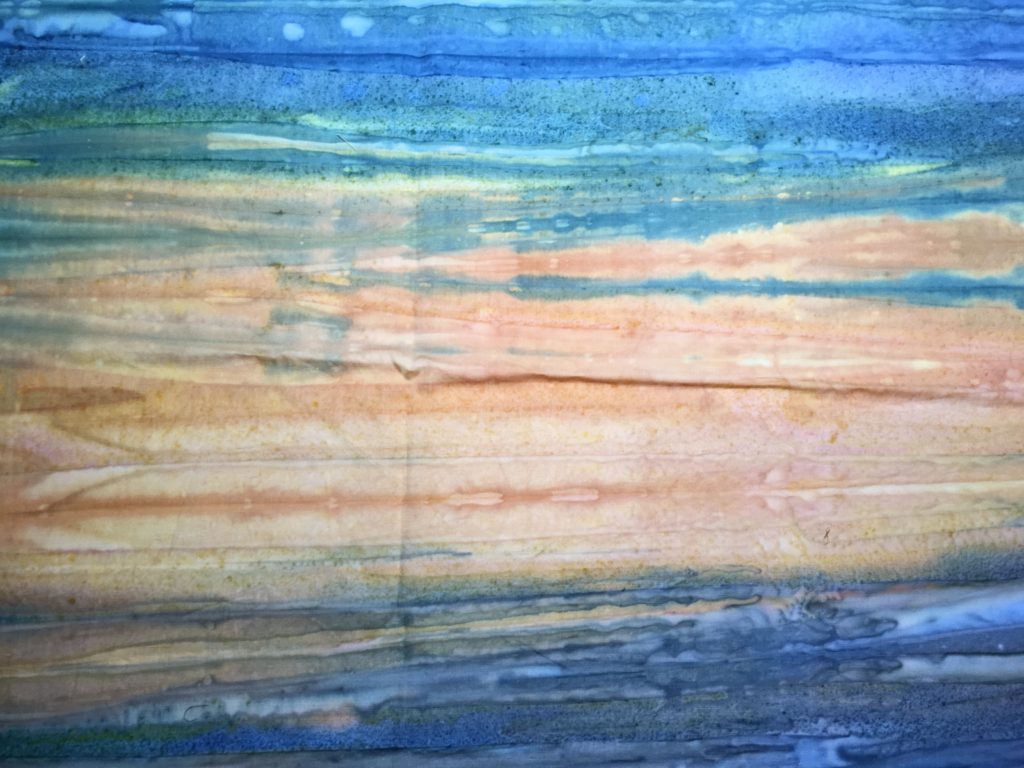
- Cut the background fabric to 18″ long x 22″ wide. Â Cut a piece of Sulky Soft ‘n Sheer Extraâ„¢ Stabilizer – 16″ x 20″ – and center it onto the wrong side of the background fabric. Then, iron, to fuse in place (Again, this is the size I chose, but you can do your project whatever size you like).
- Remove the release sheet from the traced pattern and, with your fingers, smooth the Sticky Fabri-Solvy onto the background fabric. Â
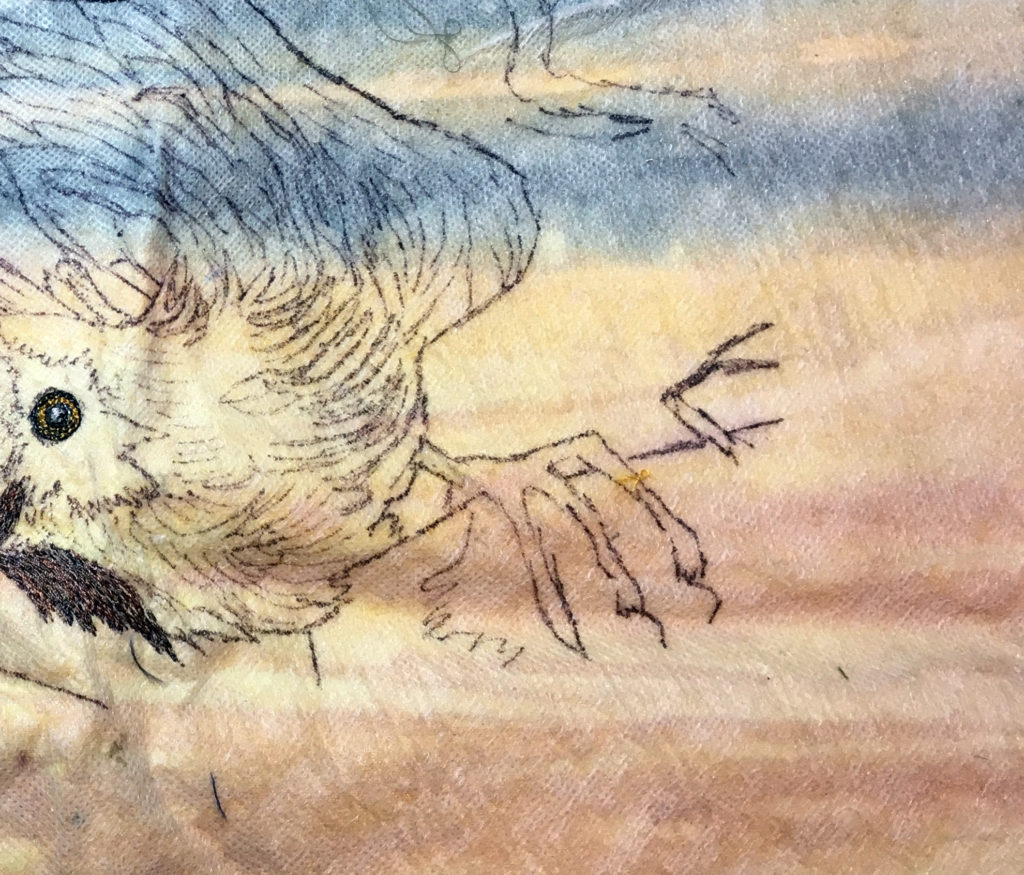
- Hoop the tail section first, using a quality wooden 6″ or 8″ embroidery hoop, and tighten the screw.
- Begin free-motion stitching the under-feathers first, starting with the tail.Â
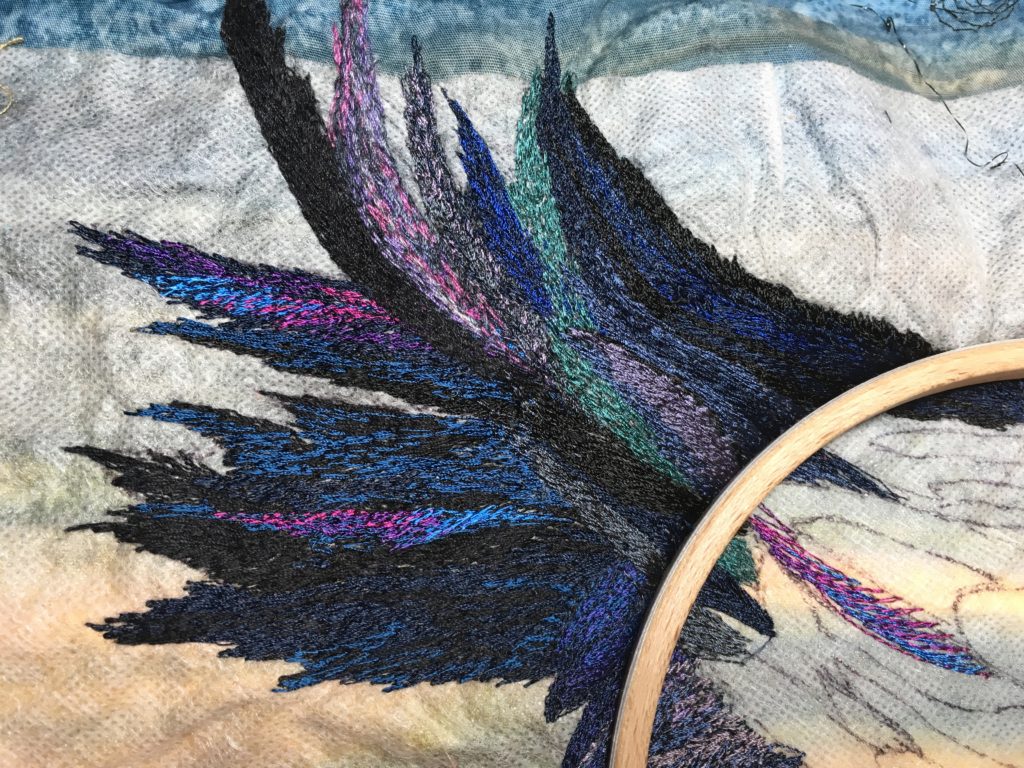
- I used Sulky 40 wt. Rayon Thread for virtually all of the bird; and 50 wt. Cotton+Steel® Thread by Sulky in the bobbin (a neutral color). For a matte finish, 50 wt. Cotton+Steel by Sulky is a great choice for embellishing the feathers, etc., as you thread paint all aspects of the bird, trunk and branches.  In addition for highlights, I used Sulky Sliver™ Metallic Thread in #142-8040 Opalescent and 145-8043 Lavender; and Sulky Holoshimmer™ Metallic Thread in 145-6017 Peacock Blue to highlight the feathers.  For the sun: 142-7011 and 142-7007 Sulky Original Metallic Thread; and 145-6007 Gold Holoshimmer.  Be sure to thread paint the under-feathers first, then the feathers that lay on top. Refer to your photo often and study it to see the feather growth pattern.
- Re-hoop each section moving towards the body, head and then shoulders. The wings are last because those feathers lay over previously stitched feathers.
- For the eye, stitch slowly in a small circle starting from the outside to inside.  Alternative method – use a Sharpie® Permanent-Ink, Extra Fine-Line Marker.  I used the zig-zag stitch in a 3.0 width to embellish the branches and fine extensions of the branches reaching into the sky.Â
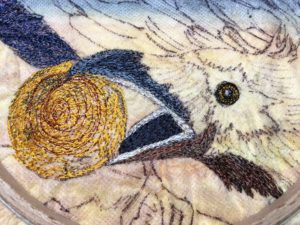
- Sulky Sticky Fabri-Solvy dissolves in water and the pattern will be removed completely once you have completed your project. HINT: Once you have rinsed the Sticky Fabri-Solvy away, place the project on a surface that you can pin into, so you can block it by gently pulling and stretching your piece. Let it dry with the pins in place. If you have any puckering, press with a steam iron on the wrong side while gently pulling as you work out the puckers. Any remaining puckers will disappear when you quilt your piece with batting and backing. Â HINT: Â If you are using polyester bobbin thread you need to be sure your iron is set for polyester. and you may want to use a press cloth. Polyester thread has a low melting point.
- Before quilting, spray the wrong side of the fabric background with Sulky KK 2000â„¢ Temporary Spray Adhesive, and smooth Sulky Cut-Away Plusâ„¢ Stabilizer onto the wrong side of the background fabric. Â Pin at each corner. Â The addition of the Cut-Away Plus provides more stability. Â This will help to prevent the background fabric from puckering.
- To finish your thread painting, square up and add a border if you want. Then layer a quilt sandwich of backing, batting, and finally the top background piece – spray basting each layer with Sulky KK 2000, placing a pin in each corner.  Quilt as desired, then square up once more and attach the binding.  Don’t forget that all important label on your beautiful art quilt!
The following is an alternative method to creating this kind of art with less thread painting, using mostly raw-edge appliqué – fussy cutting the various batik fabrics representing the feathers, trunk, and branches.
Steps 1a to 6a:
1a. Â For this method, prepare your background batik fabric by ironing a piece of Sulky Fuse ‘n Stitchâ„¢, Â 2″ smaller than the background piece, onto the wrong side.
2a. Â Trace the pattern onto a piece of lightweight vinyl to be used as a placement guide.
3a.  Select batik fabrics which will represent your feather choices, and iron a light, quality fusible web (such as Lite Steam-A-Seam2) to the wrong side of these pieces.  Small pieces or scraps of fabric are fine for the raw-edge tail appliqué.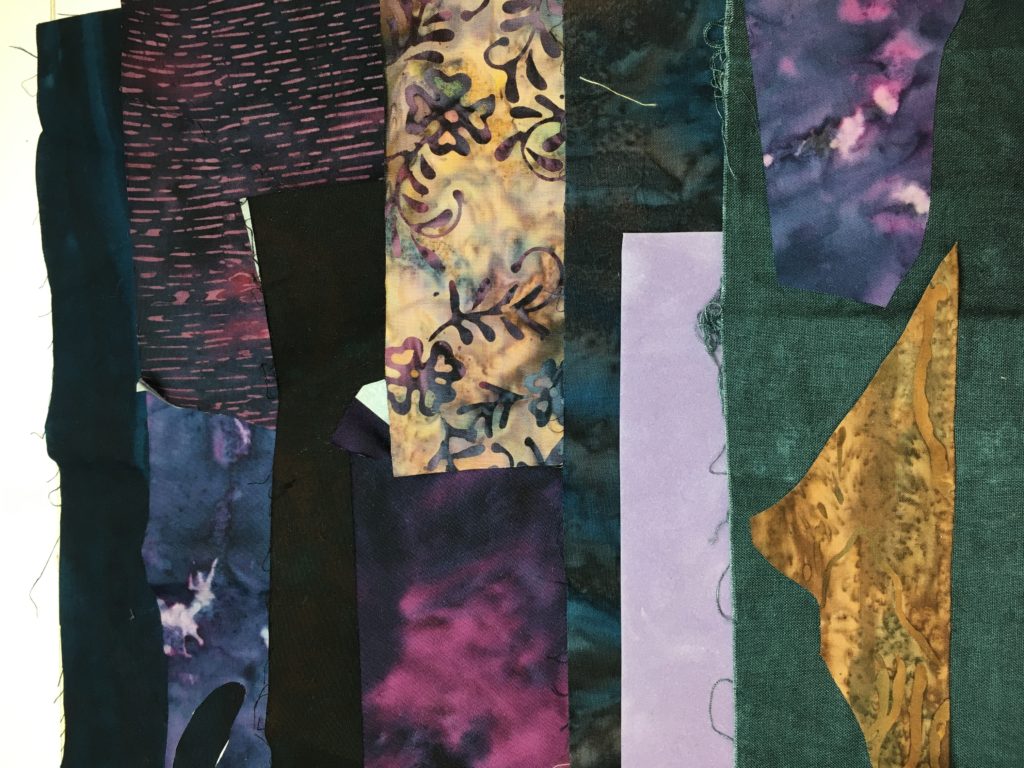 4a.  Use the a photo or outline as a guide to fussy-cut the feathers out of these fabrics. Use your imagination as you fussy-cut. The small groupings of tail feathers were lightly fused together using an appliqué pressing sheet (removing the release sheets from the pieces as you position them). All the other pieces were placed onto the background individually, always placing under-feathers first then those which lie on top.  Use your traced vinyl guide as you go, lifting it and placing the pieces under, then replacing it to see if the alignment is correct.  Fuse down lightly so you can reposition if you want.
4a.  Use the a photo or outline as a guide to fussy-cut the feathers out of these fabrics. Use your imagination as you fussy-cut. The small groupings of tail feathers were lightly fused together using an appliqué pressing sheet (removing the release sheets from the pieces as you position them). All the other pieces were placed onto the background individually, always placing under-feathers first then those which lie on top.  Use your traced vinyl guide as you go, lifting it and placing the pieces under, then replacing it to see if the alignment is correct.  Fuse down lightly so you can reposition if you want.
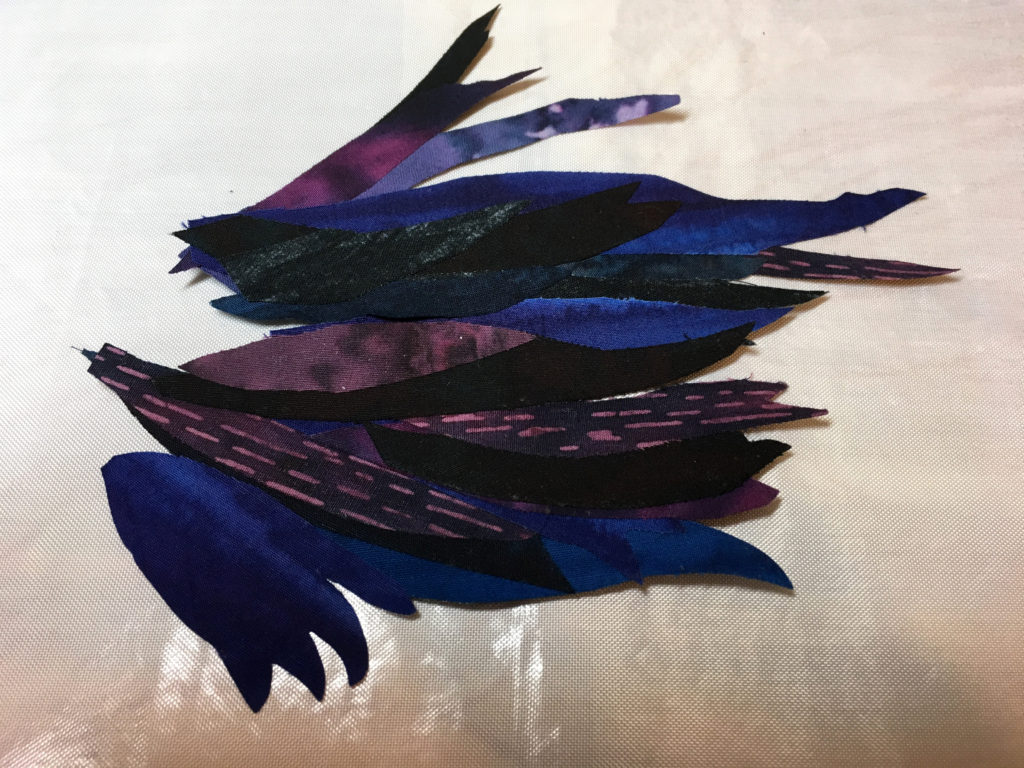 5a. Â For a placement guide, trace the image IN REVERSE with the Sulky Iron-On Transfer Pen, as shown below. Â
5a. Â For a placement guide, trace the image IN REVERSE with the Sulky Iron-On Transfer Pen, as shown below. Â 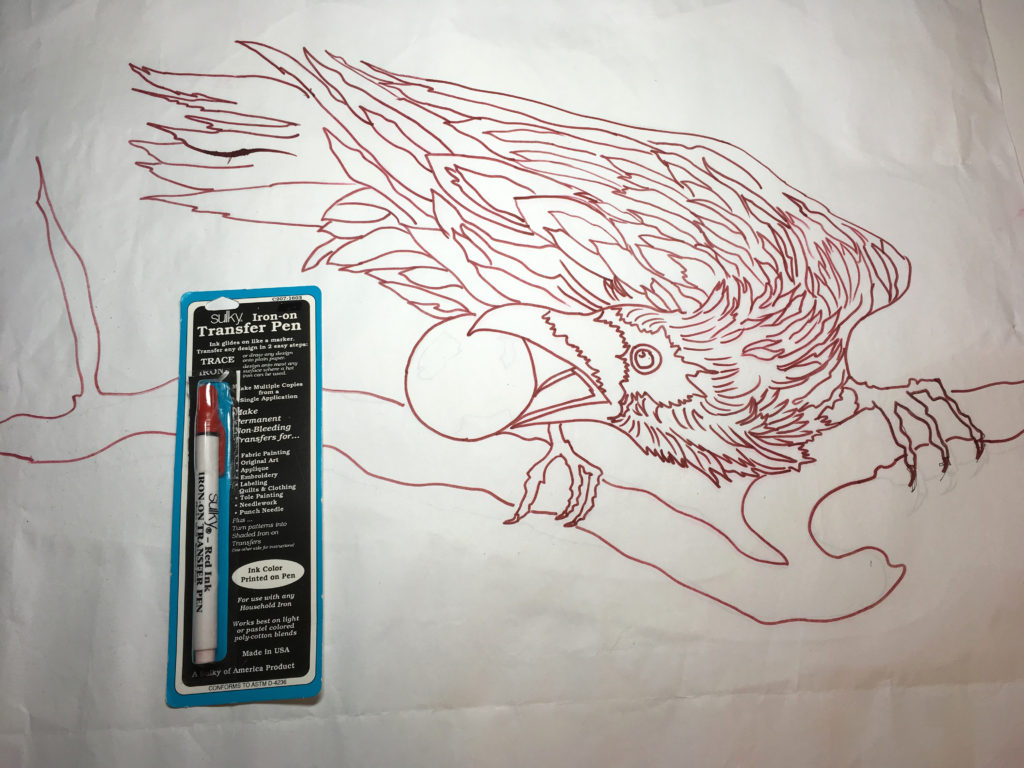 4a. Â Then position the traced, inked side of the pattern, onto the right side of the background fabric; and press with an iron on cotton setting. HINT: Â You can spray the right side of the pattern with KK 2000 to keep it in place. Â The KK will dissipate as you move the iron, but it will hold it in place in the un-ironed areas to allow you to peek under the paper from time to time to check on how the transfer is coming. Â The transferred image will then be ready for placement of the feathers that you fussy-cut from the batik fabrics. Transferred image shown below. Â
4a. Â Then position the traced, inked side of the pattern, onto the right side of the background fabric; and press with an iron on cotton setting. HINT: Â You can spray the right side of the pattern with KK 2000 to keep it in place. Â The KK will dissipate as you move the iron, but it will hold it in place in the un-ironed areas to allow you to peek under the paper from time to time to check on how the transfer is coming. Â The transferred image will then be ready for placement of the feathers that you fussy-cut from the batik fabrics. Transferred image shown below. Â 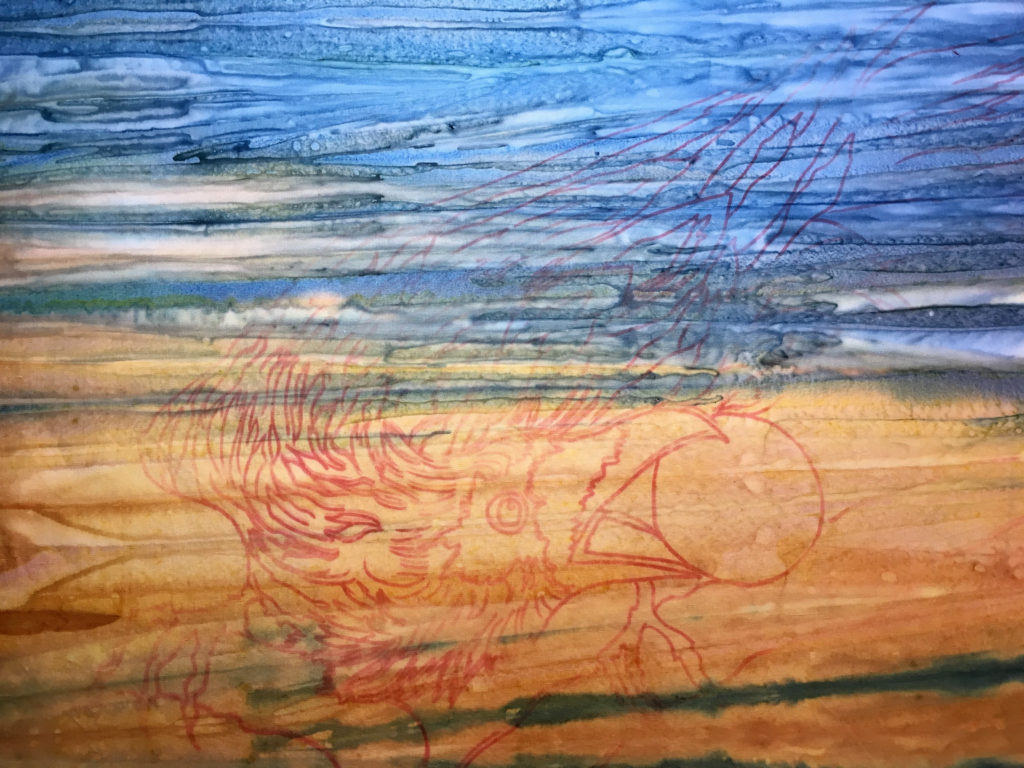 5a. Â I used the vinyl overlay as a placement guide over the design to determine if the feathers are in the correct places (Once you start placing your fabrics, you lose a lot of the transferred design details).
5a. Â I used the vinyl overlay as a placement guide over the design to determine if the feathers are in the correct places (Once you start placing your fabrics, you lose a lot of the transferred design details).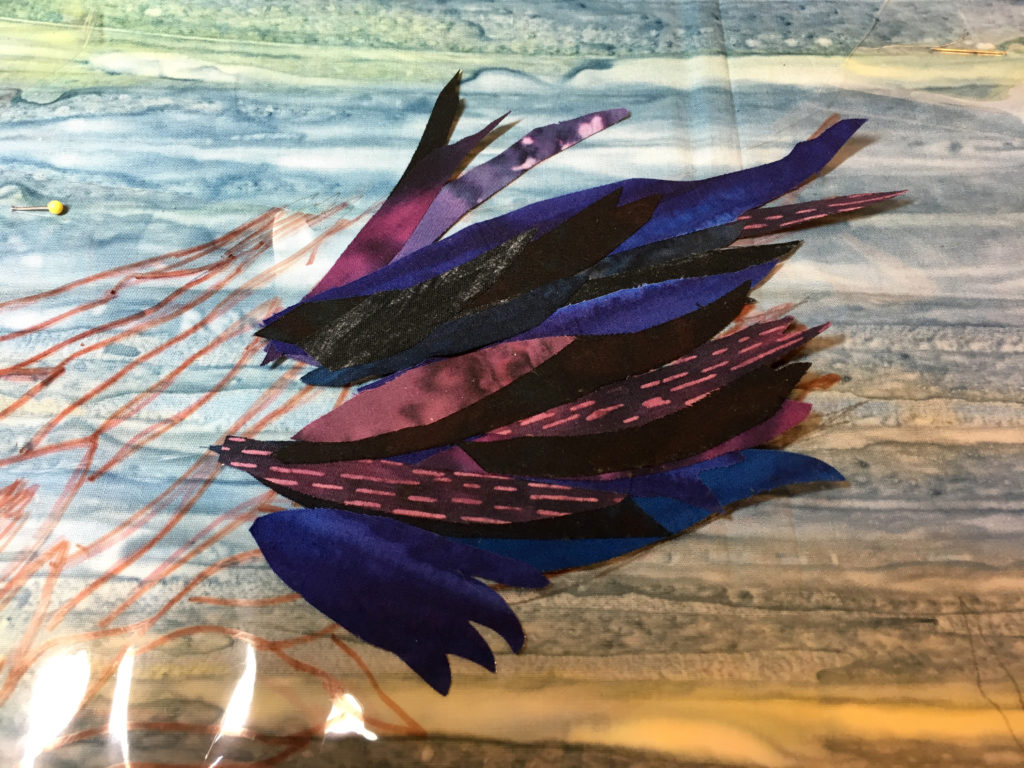 6a. Â Once all the pieces are cut and lightly fused in place, position the branch in place by fusing it down lightly. Then lightly free-motion thread paint with the Sulky 40 wt. Rayon Threads and Sulky Metallic Threads for added depth and embellishment of the feathers, sun, and rays from the sun. Â Each area of the bird is hooped and stitched as stated above in steps 6-8.Â
6a.  Once all the pieces are cut and lightly fused in place, position the branch in place by fusing it down lightly. Then lightly free-motion thread paint with the Sulky 40 wt. Rayon Threads and Sulky Metallic Threads for added depth and embellishment of the feathers, sun, and rays from the sun.  Each area of the bird is hooped and stitched as stated above in steps 6-8. 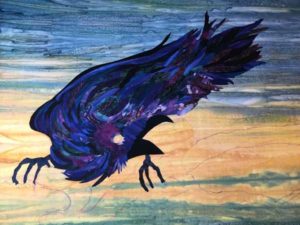
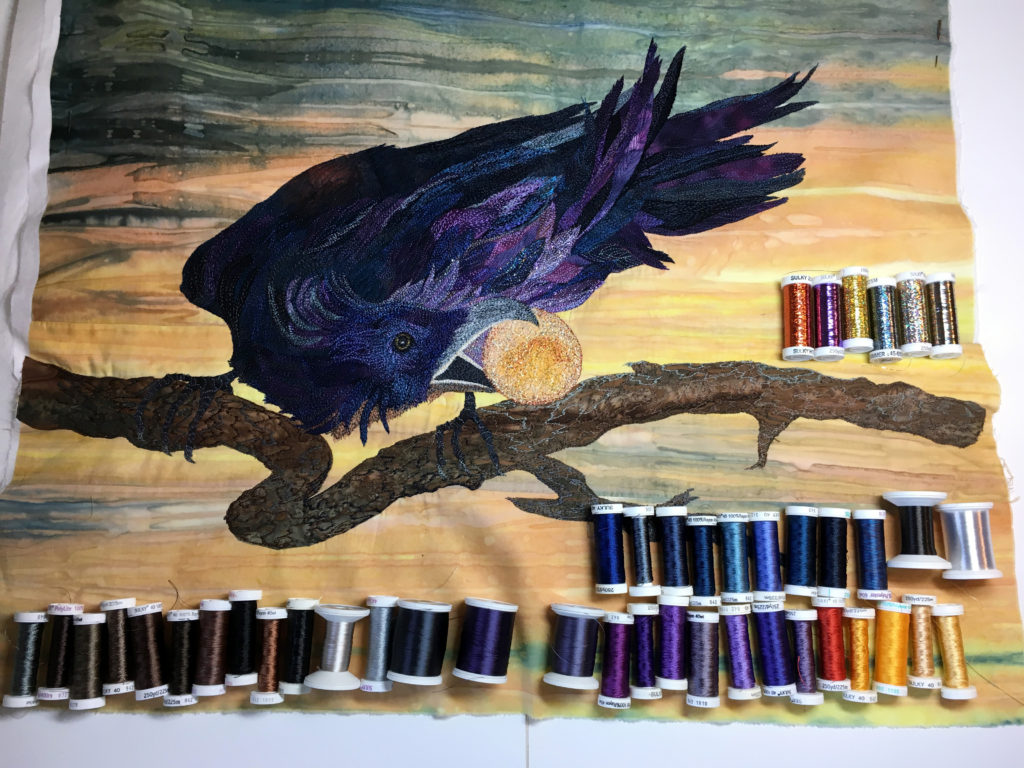
Follow the finishing steps #7, 8 and 11 in the first section to finish your art quilt.
 This blog post is by guest blogger Chris Eichner, Sulky Certified Teacher, Fiber Artist, and Designer. She has contributed to several Sulky books and our educational programs.
This blog post is by guest blogger Chris Eichner, Sulky Certified Teacher, Fiber Artist, and Designer. She has contributed to several Sulky books and our educational programs.

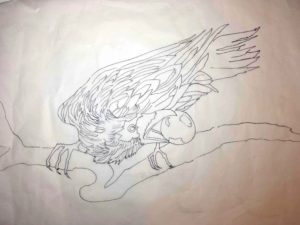

Incredible! and beautiful. So generous to share the ‘how to’ – really inspirational. Very tempted to try something although I know I will not do Chris’ work and tutorial justice!
So glad you enjoyed it! Give it a try!
I loved this quilt and the tutorial. am trying to determine how to save this . Can you suggest how to do this?
If you have a Pinterest page, you can Pin it to that. On this blog post, hover over any photo and you’ll see a little red button in the top left-hand corner of the photo that says “Save”. If you click that, it will save the post to your Pinterest page!
Also, at the top of the post, on the right, if you click where it says “Download PDF” it gives you the option to save the post as a PDF. Let me know if you have anymore questions!
I shared this tutorial from the top of my iPad screen and moved it to iBooks as a pdf
Wow! This is really great!! And I love that you gave both full thread painting and appliqué options!!
AMAZING AND SO MUCH TALENT AND INSPIRATION
Chris it is so amazing, Ravens are my bird! I love it, I may even try it.
I’m so confused. It looks like the orientation of the Raven changes in the two sets of instructions. What am I missing here?
She is showing two different techniques. One technique uses Sulky Transfer Pens and for that technique, you must trace the image in reverse so it will iron on the correct way. That may be why it looks a little confusing. I hope this helps!